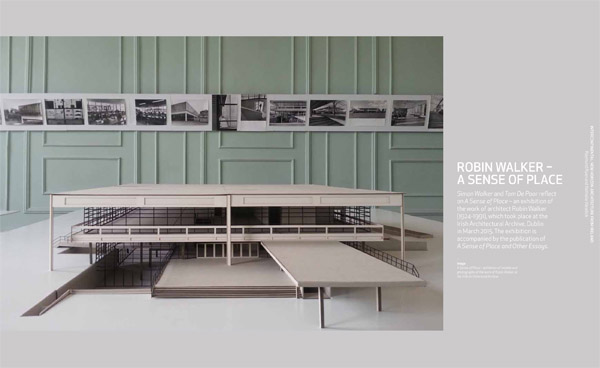
A paper architecture
Shane deBlacam opened the exhibition on March 19 last by reading Seamus Heaney’s poem ‘An Architect’ which he had written for Robin.
He fasted at the doorstep of his gift
Minding the boulder and the raked zen gravel
But no slouch either when it came to whiskey
Whether to lash into it, or just lash it out.
Courtly always, and rapt, and astonishing
Like the day on the beach when he stepped out of his clothes
And waded along beside us in his pelt.
Speculating, intelligent and lanky,
Taking things in his Elysian stride,
Talking his way back into sites and truths
The art required and his life came down to:
Blue slate and whitewash, shadow-lines, projections,
Things at once apparent and transparent,
Clean-edged, fine-drawn, drawn-out, redrawn, remembered....
Exit now, in his tweeds, down an aisle between
Drawing boards as far as the eye can see
To where it can't –
until he sketches where.
(The Spirit Level, 1996)
The suite of original photographs by John Donat of buildings by Robin Walker filled the horizon on the archipelago of model buildings, a gloss frieze on an ideal city waist height on the piano nobile of 45 Merrion Square. The astonishing output of 15 years floated all white scaled 1:50 as far as the eye can see. This evening, the Archive is a studio again –card models made, again and once again, perhaps, by another generation, posing between drawing and fact, rehearsals for construction, reconstructions, a paper architecture cut and paste on the section line, made very thin.
Ballinteer, Maynooth, Rathfarnham. Belfield, Wolfe Tone Square, St. Mary’s Lane, although the full-scale buildings are nearby, the models articulate the corners, to frame and infill his first building, now threatened on Baggot Street, or slope off the slab to trap the space between cave and glider at Kinsale, or not push up as expected but down pulling cataracts of space into sunken courtyards now ruined at UCD.
The restaurant makes a beautiful model, table atop table, fluorescent sprayed steel angles prop in the happy yellow of enabling works. The homage is handmade and exacting :a parenthesis-clean-edged, fine-drawn, drawn-out, redrawn, remembered.
‘I knew him in two parts of the year. August in west Cork, in Bothar Buí, near Ardgroom and Kilmacillogue on the Beara Peninsula where he and Dorothy were generous hosts - and at Christmas in Saint Mary’s Lane, in Dublin. His dress was extraordinary, unlike anybody else in Dublin other than Gareth Browne. He wore home spun, hand-woven white wool tweed pants and jackets, sometimes dark colours and I recall often pepper and salt colour. Shirts were invariably starched oxford button-down collar cotton, occasionally linen with brightly coloured fine loose knitted ties often designed by Pat Scott and made by Dorothy.’
Speaking at the exhibition launch Shane de Blacam also referred to The Redress of Poetry where Seamus Heaney ‘talks about Robin using words which have architectural resonances, words like squarings, pulleys, negotiation and crossing from the domain of matter of fact and the imagined.’
A Sense of Place and other essays is a collection of the architect’s writings, photocopied by himself in the late 1970s and parsed by his terse drawings. His urgent descriptions of the Pulleen propositions and agile essays on his quest of modernism are lovely. There is one portrait on page 144, taken in1985 by Diana Michener where he is pictured from above, wearing a spotted kerchief and check shirt, against another composition of universal sections, smiling. It is one of this series of multipoint perspectives -flying columns- made towards the end in pen and ink on tracing paper, which is reproduced as the dust jacket.
The poet asked the architect once was it possible for architecture to be ironic? His featured short address of 1979 to the Irish Concrete Society suffices.
#